Stories
Military Mode

Military chic is a classic example of females appropriating elements of male attire. Combat gear, flying kit and officers’ dress uniforms have all inspired a multitude of fashion looks over the years. Although the translations of military dress are less literal these days, derivations continue to appear.
Details such as braiding, badges, stripes, medals, rank and unit insignia, metal buttons and buttoned-down patch pockets help to articulate the look. A common feature on regulation jackets, shirts, vests and pants, the soldierly patch pocket was initially designed to hold personal items and ammunition but on fashion garments it assumes a purely decorative role.
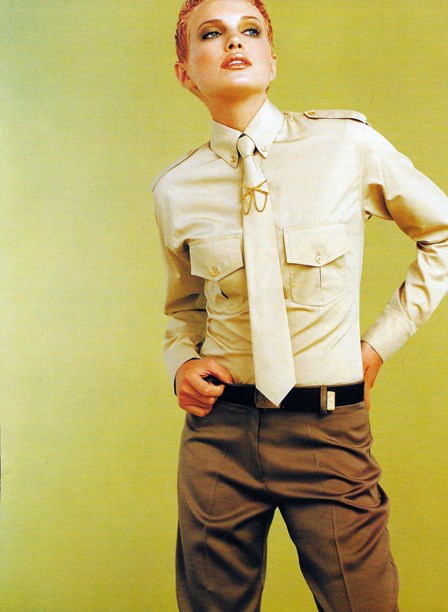
Karen Walker utility shirt with patch pockets and matching tie. Fashion Quarterly, autumn 1997. Photo by Tony Drayton.
Launched in 1914, the Burberry weatherproof trench-coat was created specifically for British troops engaged in trench warfare in World War One. In the 1920s it was adapted for women and went on to become a fashion icon, in most cases retaining its original design details – a belted waist, epaulettes (shoulder straps), a double back yoke and buckled cuff straps. Today, even if the belt has a buckle it is seldom used, the belt being knotted instead, and the traditional khaki or beige gabardine has largely been supplanted by other fabrics and colours. In 2004, in a New Zealand Fashion Week dominated by satin, Liz Mitchell proposed a black satin trench-coat in lieu of a dress for after-five while Karen Walker opted for more conventional fabrics in grey, inky blue, cream and turquoise.

Karen Walker trench-coat photographed on the catwalk at New Zealand Fashion Week 2004.
During World War One, the Auckland department store Smith & Caughey Ltd stocked Burberry trench-coats. Also agents for British military tailors Messrs. Hobson & Son, they supplied over 500 officers of all ranks with hand-tailored uniforms over a period of five years. The double-breasted greatcoat that formed part of the uniform was another item of military clothing that would later find its way into women’s wardrobes.

Service dress advertisement, Smith & Caughey Ltd, 1916.
Founded in 1940, TEAL, the forerunner to Air New Zealand, appointed its first stewardesses in 1946, one year after World War Two ended. Worn with a shirt, tie and Glengarry 'bonnet' (a Scottish regimental cap), their uniforms were styled on military lines, giving them an air of authority.

TEAL stewardesses dressed for service in their military-style greatcoats and Glengarry ‘bonnets’, 1946.
An early 1980s 'military' suit advertised by Thornton Hall conformed to the then current trend for Amazonian shoulders, volume and ankle-length skirts. Ready for action of the urban kind, the message was clear – don’t mess with me.
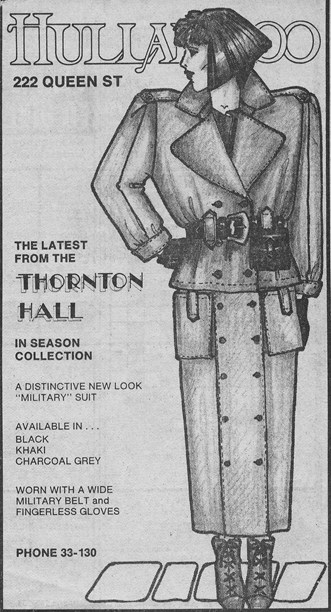
Thornton Hall version of the military look, early 1980s. Artwork by Brian Molyneux.
In 1982, Apparel magazine reported an interest in uniforms, with a swing away from "the popular khakis to the military blues of the air force". A leather jacket by Knights Tailors of Invercargill, complete with large two-way pockets, a sheepskin collar, epaulettes and rib knit trim, was described by Apparel as "reminiscent of an RAF World War Two flying jacket", and Ward Wells range of cord, velveteen, flannel and yarn dye pieces, presented at that year’s New Zealand Fashion Fair, as "a salute to the flying aces of yesteryear".
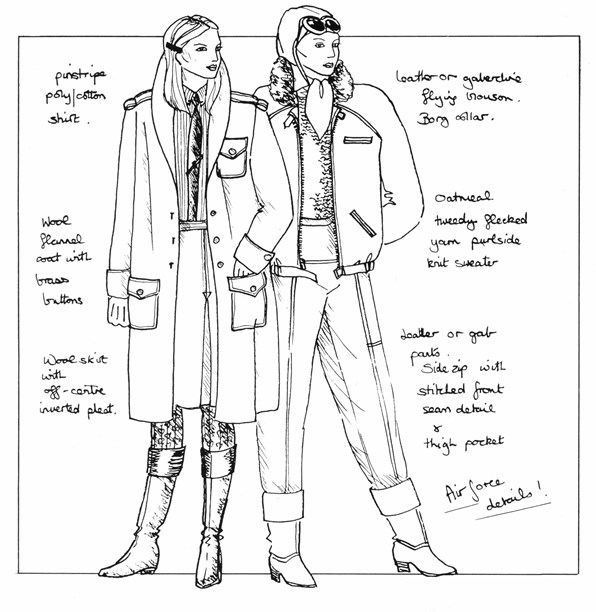
Sketch depicting the various components of the aviator look. Apparel magazine, 1982.
In her white flying suits and helmets, the famous New Zealand aviatrix Jean Batten cut a glamorous figure. She always took a white silk dress with her on her flights and applied lipstick before alighting from her plane. In 1988, Thornton Hall designed the Jean Batten Solo Flight collection, a tribute to the aviatrix’s record-breaking solo flight from England to New Zealand in 1936. The collection included baggy pants, long shorts and jumpsuits, also t-shirts and a French cotton cropped flying jacket with zip-out sleeves.
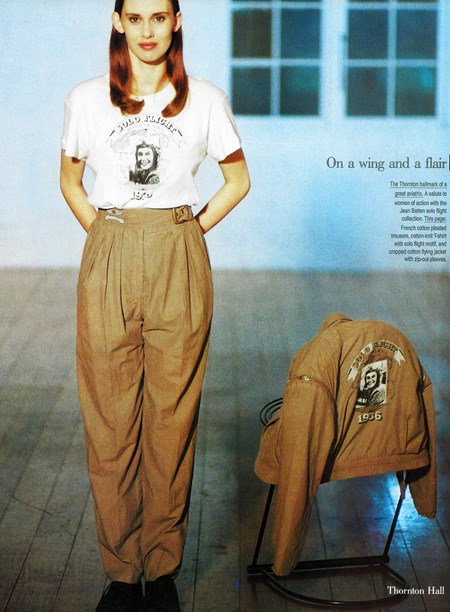
Thornton Hall tribute to Jean Batten. Fashion Quarterly, spring 1988.
Fashion designers tended to adhere to military colour codes when creating uniform-inspired pieces, the two most predominant being khaki, an Urdu word meaning 'dust', first adopted by the British Indian Army in the mid-19th century, and olive drab, the colour of the standard fighting uniform for US GIs in World War Two.

Olive drab wool crepe jacket and lilac cotton shirt by Keith Matheson, worn with a wedge cap and badge. Fashion Quarterly, autumn 1997. Photo by Tony Drayton.
By the end of World War Two, camouflage-patterned fabrics had been developed. They were designed in colour combinations suited to specific locations – jungle, urban or desert. Camouflage prints remain popular today, lending themselves to softer shapes and fabrics. Rather than blending into the background as they were intended to, in the modern fashion context they make the wearer stand out.
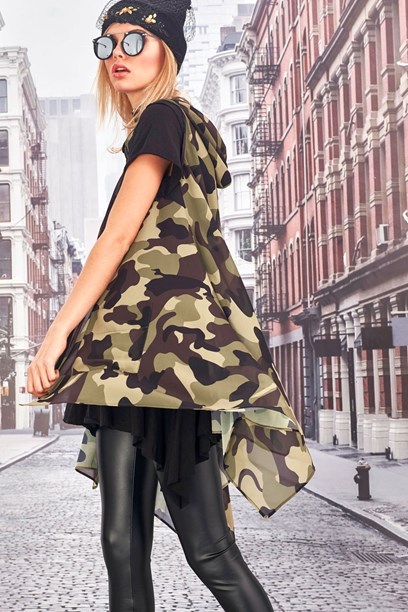
A new guise for the camouflage print. Polyester hooded vest with zip-up front from Trelise Cooper Pre-Fall collection 2018.
Whenever a summer fashion season called for gold and white, designers invariably responded with feminised versions of white military uniforms, usually substituting a skirt for trousers. Associated more with the navy than the army – think Richard Gere in An Officer and a Gentleman (1982) – the crisp tailored whites with stand-up collars, gold buttons, epaulettes and flap pockets fired the imaginations of Barbara Lee, Patrick Steel and others.

White summer suit with military details by Barbara Lee. Fashion Quarterly, summer 1996.
Some designers delved further back in time for military inspiration. For Rosalie Gwilliam, the 1989 Benson & Hedges Fashion Design Awards provided her with the opportunity to show off her fanciful creation, a short black velvet jacket and billowing cream silk skirt. Featuring elaborate frogging and braided collage, the jacket referenced those worn by Hussars, French cavalrymen in the Napoleonic wars. Rosalie’s entry was nominated in the After Five High Fashion category.
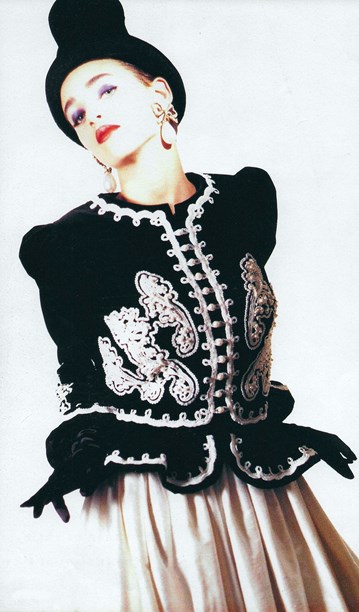
Rosalie Gwilliam revisits the Napoleonic wars. Benson & Hedges Fashion Design Awards, 1989.
At the inaugural New Zealand Fashion Week in 2001, Tanya Carlson transported the audience back to Tsarist Russia. Her collection, The Fall of the Winter Palace, was based on a fictional heroine called Anoushka, an aristocrat having an affair with someone beneath her in rank, an army officer or an Imperial guard. A mix of imagined court, peasant and military dress, the collection included grey guardsmen’s greatcoats and romanticised versions of officers’ jackets. One of the jackets, hand-painted and decorated with threadwork to simulate the look of military embroidery, is held in the collection at Te Papa Tongarewa.
The point of reference for Keith Matheson, a label noted for its sharp tailoring, was the colourful uniform of the British Grenadier Guards whose lineage can be traced back to the 1600s. In the 1993 Keith Matheson winter collection, long-line jackets, meticulously cut in red wool crepe and embellished with the requisite gold buttons and braid, were paired with black pants and skirts in the same fabric.
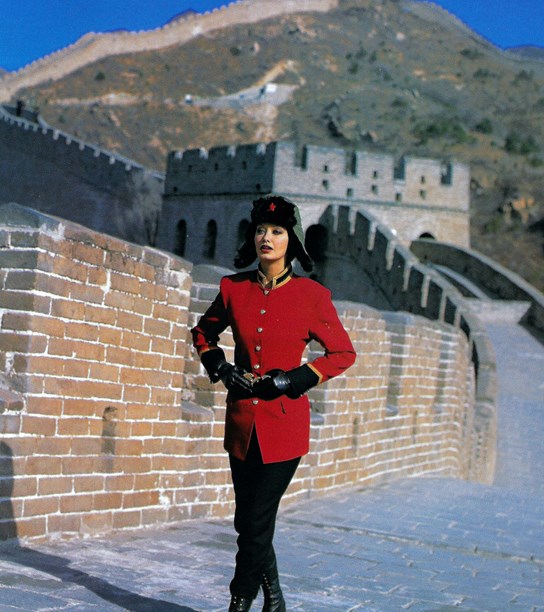
Keith Matheson jacket inspired by the uniform of the British Grenadier Guards. Photographed in China for Fashion Quarterly by Mark Arbeit, 1993.
The military fashion aesthetic continues to engage designers, who reinterpret it anew, borrowing a bit from here and a bit from there, mixing the masculine with the feminine, the present with the past. Locally, the last major military moment was in 2015, when labels as diverse as Cooper, Moochi, Harman Grubisa, Zambesi and WORLD got creative with everything from campaign dress to jumpsuits and jackets.
In Love Letters, Kate Sylvester’s 2020 autumn/winter collection, the designer pays tribute to her parents’ courtship in the 1950s. While aspects of her mother’s '50s wardrobe and her love of flowers influenced the collection’s more feminine pieces, military-inspired overcoats, trench-coats and suits with utility pockets allude to the time her father spent in the NZ Territorial Army as a young man.
Text by Cecilie Geary. Banner image from 'Hey Soldier!' fashion shoot, Fashion Quarterly, autumn 1997.
Published May 2020.